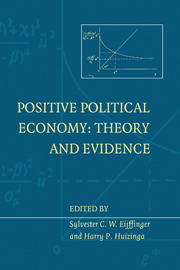Book contents
- Frontmatter
- Contents
- List of figures
- List of tables
- List of contributors
- Foreword
- Introduction
- I Monetary institutions and policy
- II Exchange rate policy and redistribution
- 7 Exchange rate anchors and inflation: a political economy approach
- 8 Why capital controls? Theory and evidence
- 9 The political economy of the Exchange Rate Mechanism
- 10 Unemployment benefits and redistributive taxation in the presence of labor quality externalities
- Index
9 - The political economy of the Exchange Rate Mechanism
from II - Exchange rate policy and redistribution
Published online by Cambridge University Press: 05 September 2013
- Frontmatter
- Contents
- List of figures
- List of tables
- List of contributors
- Foreword
- Introduction
- I Monetary institutions and policy
- II Exchange rate policy and redistribution
- 7 Exchange rate anchors and inflation: a political economy approach
- 8 Why capital controls? Theory and evidence
- 9 The political economy of the Exchange Rate Mechanism
- 10 Unemployment benefits and redistributive taxation in the presence of labor quality externalities
- Index
Summary
An open economy model
The model, set out in table 9.1, is a distillation of the dependent economy model of Swan (1963); its derivation is based on Minford (1992) and is explained fully in the appendix. The time horizon is the “intermediate run,” where capital is, at least to some degree, fixed.
(1)is the supply curve of traded goods; (2) is the demand curve for traded goods; (3) and (4) equate the implied demand for non-traded goods with the output of these, by market-clearing through PNT; (5) is the overall output identity; (6) is the national budget constraint in the absence of long-term loans – it forces the current account of the balance of payments into balance. For convenience, it ignores the payment of net interest to foreign residents that would result from the integral of past current account deficits (this would in fact lower domestic demand pro tanto), but our focus here is on the effects of the ERM and this element depends on demand policies pursued by the government – a separate issue, so we omit it (or equivalently, treat it as exogenous); (7) is the open economy supply curve. Its derivation assumes that non-traded goods are more labor intensive than traded goods and have a higher elasticity of labor demand to the product real wage.
To pay for the cost of the subsidy, we assume the government raises either a tax on non-traded goods or a general consumption (or income) tax, following the normal assumption that it is impossible for the government to levy non-distorting taxes.
- Type
- Chapter
- Information
- Positive Political EconomyTheory and Evidence, pp. 253 - 264Publisher: Cambridge University PressPrint publication year: 1998



